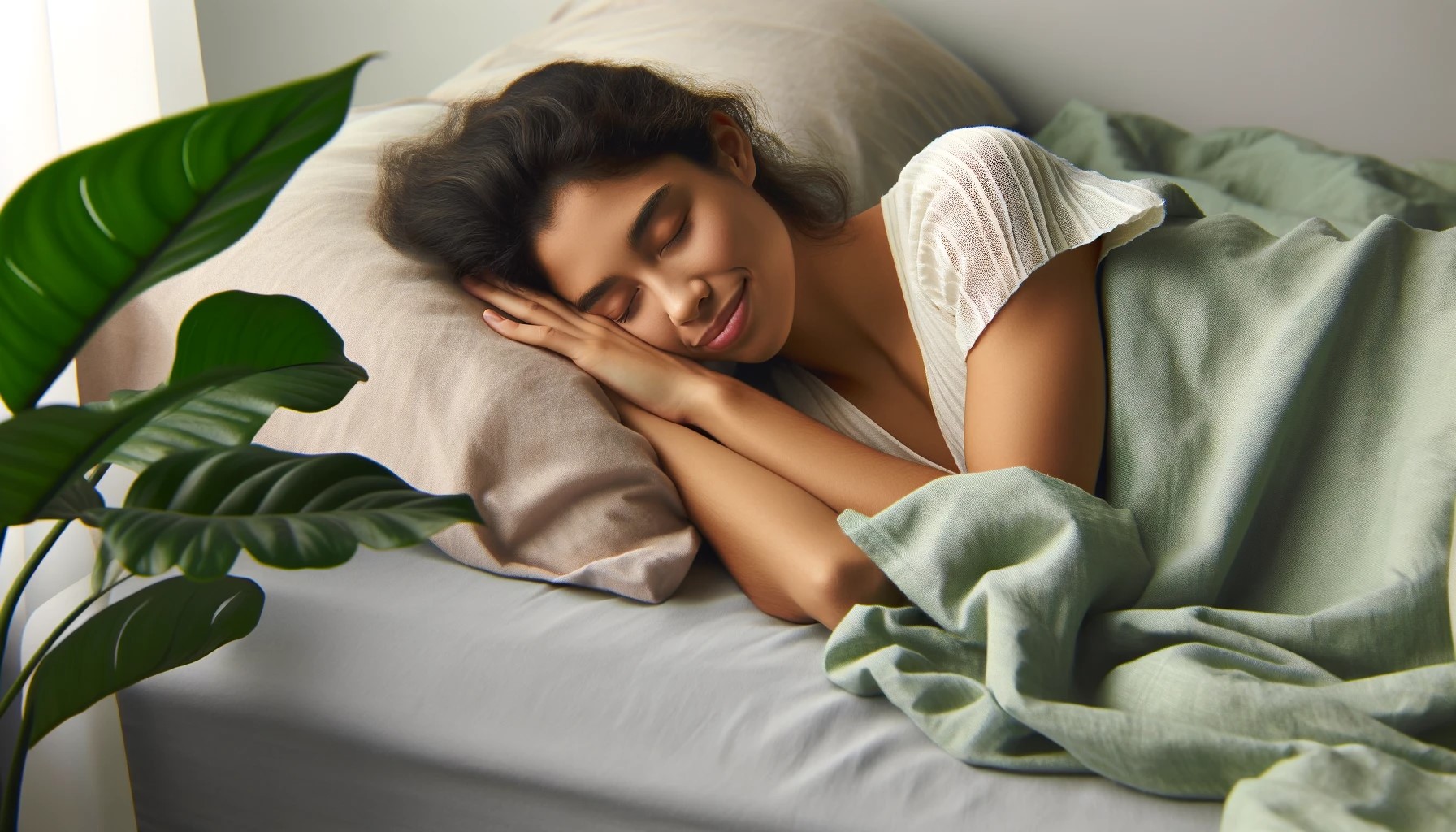Disclaimer: This article is for educational purposes only and is not intended as health or medical advice. Please consult with medical doctors and healthcare experts to determine the best approach for your individual needs.
Sleep, an integral part of our daily routine, is often elusive when stress and anxiety invade our minds. It’s not about shutting your eyes and hoping for the best; it’s about harnessing specific techniques that stimulate the body’s natural sleep mechanisms. But why is falling asleep quickly so beneficial?
Research indicates that a longer onset to sleep can signify stress, resulting in less overall sleep and a potential decrease in the restorative stages of sleep – vital for cognitive functions and memory consolidation. A healthy sleep onset usually ranges from 10 to 20 minutes from the moment your head hits the pillow, suggesting a well-balanced sleep drive and a conducive sleep environment.
A brief explanation of sleep cycles and stages paints a clearer picture. Sleep is segmented into stages that range from the light transitional phase to deeper restorative phases (such as REM sleep), with each playing a pivotal role in health. It’s in these deeper stages that the body conducts crucial repair work. Quick sleep onset may help ensure you cycle properly through these stages, critical for feeling refreshed and alert come morning. Now, let’s unravel the methods that can help us cross into the land of Nod almost instantly.
Relaxation Techniques
The Military Method
This method, renowned for its effectiveness, was originally designed to help soldiers fall asleep rapidly, even in the discomfort of the battlefield. Imagine yourself in their shoes: needing to find rest amidst the chaos to perform at your optimal level the next day. The process aims to relax the body and mind wholly, combining muscle relaxation, breathing techniques, and mental visualization. Not surprisingly, many have found it effective in civilian life, too.
The steps to unwind facial and body muscles are straightforward, beginning with deep breaths. Close your eyes and methodically relax every part of your face, including the muscles around your mouth, eyes, and forehead, followed by your neck and downwards. Breathing techniques intermingle with this process, allowing for a deliberate focus on exhalation, which encourages a state of calm. Visualization plays its part—imagining a serene environment or quietly repeating calming words solidifies the body’s transition to sleep.
Progressive Muscle Relaxation

Another method championed by sleep experts is Progressive Muscle Relaxation (PMR). Developed by Dr. Edmund Jacobson in the 1920s, PMR addresses the physical manifestations of stress that often inhibit the onset of sleep. Have you ever experienced that frustrating tension that holds your body rigid when all you seek is slumber?
PMR involves the deliberate tensing and then relaxing of different muscle groups, heightening the contrast between tension and relaxation. The process is typically coupled with deep, slow breathing, further enhancing relaxation. Inhale and tense a muscle group, such as your fists, for about five seconds, then exhale and release, and move progressively through the body. With each step, the boundary between wakefulness and sleep becomes increasingly blurred, as the body sinks deeper into the bed, cloaked in relaxation.
Peaceful Music and Sounds
Have you ever noticed how certain sounds or melodies can transport you to a state of tranquility? It’s no secret that auditory inputs can influence our mood and stress levels. Peaceful music and sounds create an auditory backdrop conducive to sleep. The gentle hum of white noise, for instance, can mask disruptive sounds of the outside world, cocooning you in your sleep sanctuary. While preferences can vary, many find that soundscapes of nature, like a babbling brook or soft rain, have a mesmerizing, soporific effect.
Using sound wisely plays a pivotal role in decompressing the mind. Whether it’s the steady rhythm of a heartbeat, the soft twinkle of a lullaby, or the static of white noise, these auditory cues signal to the brain that it’s time to unwind. Soundtracks specifically designed for sleep often utilize slow tempos and minimal changes in volume to sustain a meditative state. As the mind engages less and less with thoughts, the entrance to a peaceful night’s sleep becomes increasingly approachable.
Dietary and Lifestyle Adjustments
Watch What You Eat
Consuming the right—or wrong—foods can be the deciding factor between a restless night and a peace-filled slumber. Think about the last time you enjoyed a heavy meal or a coffee too late in the day—did sleep come easily? Certain foods and beverages have been shown to disrupt sleep quality significantly. Research suggests that high-fat meals, heavy spices, or high-sugar foods before bedtime can create discomfort or stimulate alertness at the very time you wish to wind down.
On the flip side, some foods contain nutrients that are known to promote better sleep. Foods like almonds, walnuts, cherries, and fatty fish are rich in melatonin, magnesium, and omega-3 fatty acids, all of which are associated with improved sleep quality. It’s essential to consider the timing, too. Avoiding stimulants like caffeine and nicotine several hours before bedtime can prevent the tossing and turning often associated with their intake.
The Role of Exercise
Physical activity holds a myriad of benefits beyond muscle strength and cardiovascular health; it’s a powerful ally in your quest for rapid sleep onset. But when and how you exercise can greatly influence your nighttime experience. Have you ever concluded a vigorous workout feeling too energized to sleep? Timing matters—exercise enhances the body’s temperature and endorphin levels, which can be invigorating if done too close to bedtime.
Nonetheless, regular physical activity—particularly aerobic exercises—has been proven to deepen sleep and shorten the time it takes to fall asleep. The sweet spot? A study from the Sleep Foundation suggests that moderate aerobic exercise like a brisk walk, when performed earlier in the day, allows cortisol (the stress hormone) levels to normalize by nightfall, facilitating the onset of sleep. Recommendations point toward establishing an exercise routine that is consistent and mindful of the clock, setting the stage for a serene night ahead.
Environmental and Habitual Changes
Optimal Sleeping Environment

Your sleeping area: is it a temple of tranquility or a den of distraction? Crafting an environment conducive to sleep can dramatically decrease the time you spend trying to drift off. Room temperature is a subtle yet critical element—numerous studies have found that cooler environments support faster sleep onset and more profound sleep stages. Alongside this, the lighting should be dim, mimicking the natural fade of the sun, and noise should be kept at a minimum, or replaced with the consistent, calming sounds discussed earlier.
Minor adjustments can reshape your sleep setting entirely. Consider blackout curtains, a cooler thermostat setting, or adding plants to enhance air quality—all contribute to a restful atmosphere that invites sleep. Some people benefit from the use of ergonomic pillows or mattresses tailored to their sleeping positions, further minimizing discomfort that can lead to wakefulness. Imagine walking into your bedroom to feel a wave of calm embrace you—the right environment can indeed weave that magic.
Sleep Hygiene Practices
Sleep hygiene consists of behaviors that promote consistent, uninterrupted sleep. Have you ever noticed how a random late-night disrupts your entire sleep schedule? That’s because our bodies thrive on routine—the circadian rhythm, our internal biological clock, craves regularity. Establishing a calming pre-sleep routine, like reading or a warm bath, can signal to your body that it’s time to wind down.
Moreover, going to bed and waking up at the same time daily fortifies your sleep-wake cycle, reinforcing the body’s natural inclination to sleep. This isn’t to say spontaneity should be entirely forsaken, but rather that a foundation of regularity allows occasional variations without significant disruption to your overall sleep health. Consequently, a consistent sleep schedule is not just about discipline; it’s about setting the internal stage for rapid, peaceful sleep onset nightly.
Supplementary Aids for Sleep
Melatonin Supplements
Among the constellation of sleep aids, melatonin supplements shine brightly for many seeking nocturnal repose. Melatonin, often dubbed the “sleep hormone,” is naturally produced by the pineal gland and plays a critical role in regulating sleep-wake cycles. Have you considered reaching for a pill to hasten your journey to dreamland? You wouldn’t be alone, as the use of melatonin has soared, especially among those with irregular schedules or for mitigating jet lag.
Melatonin’s role in the sleep cycle is profound—its levels rise in the evening, signaling the body to prepare for sleep. While the evidence supporting its use to reduce sleep onset time is compelling, it’s wise to heed guidelines for melatonin use. Experts typically recommend starting with the lowest possible dose, taking it about 30 minutes before bedtime. As with any supplement, it’s crucial to consult with a healthcare professional, ensuring it’s fitting for your specific circumstances and won’t interact with other medications.
When to Seek Professional Help
Recognizing when sleep struggles need professional intervention can be as crucial as any sleep-inducing technique. Chronic insomnia, defined as difficulty falling or staying asleep for at least three nights a week over three months, affects many. If you’ve ever tossed and turned most nights, counting more sheep than you care to remember, it might resonate deeply with you.
When sleeplessness persists, it’s suggested to consult a healthcare professional to explore the underlying causes. They can offer a deeper dive into potential medical or psychological reasons, such as sleep apnea, anxiety, or other conditions. Sleep disorders can profoundly affect quality of life, and early intervention can be key to reclaiming the rest that’s so essential. Exploring and addressing these factors with the help of a sleep specialist can lead to tailored solutions that bring back the night’s comforting embrace.

Final Thoughts
In wrapping up, isn’t it empowering to recognize the breadth of approaches available to coax sleep ever closer, night after night? From the military’s precision relaxation tactics to the gentle nudging of dietary adjustments, these strategies create a compendium of options for inviting restful slumber quickly. Your personal sleep needs may vary, and thus, an individualized combination of practices may offer the most benefits.
We’ve walked through a variety of methods and adjustments, each contributing uniquely to a more swift transition to sleep. It’s the harmonious blend of relaxation techniques, environment optimization, and lifestyle considerations that often leads to success. Embrace these tools, experiment, and take note of the changes that lead to significant improvements in your sleep onset. Remember, sleep is not a one-size-fits-all matter; rather, it is a deeply personal journey. May your path lead to tranquil nights and vibrant mornings.
FAQs
Absolutely. Relaxation techniques like the Military Method and Progressive Muscle Relaxation work by calming the mind and releasing tension from the body, which can significantly hasten sleep onset when practiced regularly.
Melatonin supplements can be a safe and effective way to promote sleep for some individuals, especially when dealing with jet lag or shift work. However, reliance on any sleep aid should ideally be discussed with a healthcare provider to ensure its appropriateness and to avoid potential interactions with other medications.
A consistent sleep schedule is essential because it helps to reinforce the body’s natural circadian rhythm. This regularity can significantly improve sleep quality and make it easier to fall asleep and wake up at the same times each day.





